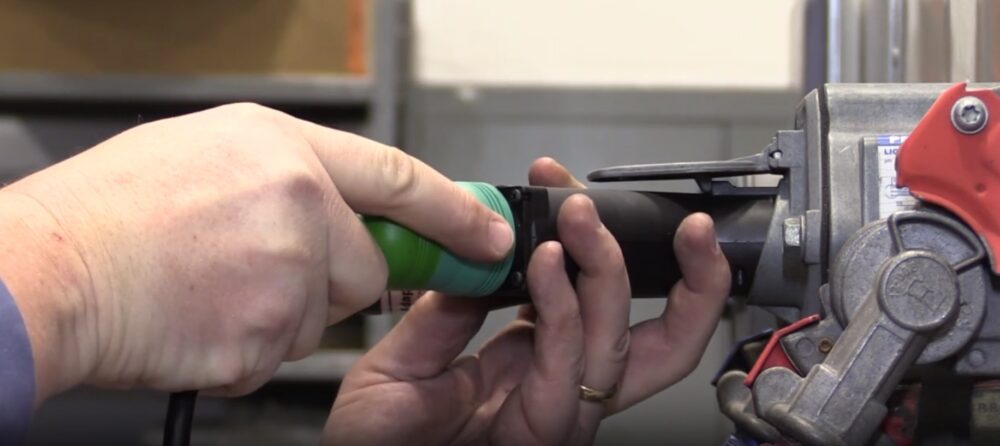Jim Linder “Fuel Injector Guru” needs no introduction to the readers of Underhood Service. His reputation as a technical writer and as a provider of quality technical training and electronic fuel injection service extends industry-wide. By now, many of Linder’s fans know that his record attempt was rained out by the third day of qualifying at the 2006 World of Speed event held September 13-16 at Utah’s famous Bonneville Speedway. Linder’s record attempt at the Utah Salt Flats Racing Association (USFRA)’s 2005 World of Speed was rained out in a similar fashion, but that meet was cancelled before Linder left Indianapolis.
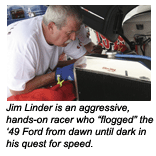 Bonneville
Bonneville
Rain at Bonneville is always a mixed blessing. On the one hand, Bonneville’s famous Salt Flats are formed by rain water washing salt into a large shallow lake. On the other hand, record attempts are often foiled by a mild overnight rain depositing a miles-wide, one-inch deep layer of water over what is one of the world’s premier venue for setting wheeled vehicle land speed records.
As the water evaporates, it leaves a perfectly flat, miles-long, concrete-smooth racing surface. Each year, Bonneville’s wet-and-dry cycle smoothes the track, allowing racers to set new class speed records at the Bonneville Nationals held in August and the World of Speed in September.
Not to say that Bonneville is an easy place to tune an engine for maximum speed. The weather can instantly change from scorching hot to cool with misty rain. Wind can also be a factor in any record attempt because it can work for or against any driver attempting to nudge his way past an existing record. If the wind blows over five miles per hour, speed attempts will be suspended until the wind dies down.
The Truck Project
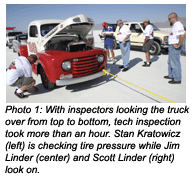 Jim Linder’s goal is to beat the USFRA’s vintage XF/PP flathead truck class record of 101.97 mph. If that speed seems modest to the younger generation, keep in mind that there’s nothing aerodynamic about a 1949 Ford pickup truck, not to mention that the power output of even a highly modified version of Henry Ford’s famous flat-head V8 rarely exceeds 200-250 horsepower at best.
Jim Linder’s goal is to beat the USFRA’s vintage XF/PP flathead truck class record of 101.97 mph. If that speed seems modest to the younger generation, keep in mind that there’s nothing aerodynamic about a 1949 Ford pickup truck, not to mention that the power output of even a highly modified version of Henry Ford’s famous flat-head V8 rarely exceeds 200-250 horsepower at best.
With that said, Linder’s business website, www.lindertech.com, has a running account of how the project was conceived and how the truck was rebuilt into a Bonneville speed racer.
Tuesday, September 12
Linder, along with truck co-owner Don Basala, Linder’s son Scott, Linder employee Stan Kratowicz and custom magneto builder Ed Starr, left Indianapolis on Sunday, just after finishing Linder’s annual Technical 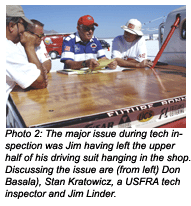 Conference. Linder’s team took turns driving the car hauler while Starr followed with his Magtech equipment trailer. After driving straight through, they arrived at Bonneville early Tuesday morning in time for technical inspection. I arrived from Colorado the night before and met Linder and his team as they were preparing for tech inspection.
Conference. Linder’s team took turns driving the car hauler while Starr followed with his Magtech equipment trailer. After driving straight through, they arrived at Bonneville early Tuesday morning in time for technical inspection. I arrived from Colorado the night before and met Linder and his team as they were preparing for tech inspection.
Technical inspection of a new racing vehicle is a rigorous, time-consuming process because the vehicle must be inspected from top to bottom for structural integrity, adequate safety equipment and conformity to class rules (see Photo 1). Linder soon 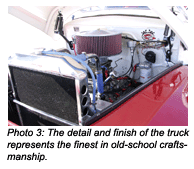 discovered that he left the upper half of his driving suit hanging on his shop wall. Fortunately, the USFRA tech inspector (see Photo 2) allowed Linder to borrow a spare top from another driver long enough to get through safety inspection while his own was being sent from Indianapolis via overnight air.
discovered that he left the upper half of his driving suit hanging on his shop wall. Fortunately, the USFRA tech inspector (see Photo 2) allowed Linder to borrow a spare top from another driver long enough to get through safety inspection while his own was being sent from Indianapolis via overnight air.
The USFRA tech crew was very impressed with the craftsmanship evident throughout the vehicle. Linder, who currently sponsors USFRA’s 130 MPH Club, had taken great pains to follow their safety regulations, not to mention assembling a show-stopper racing vehicle (see Photos 3 and 4).
After driving all night, the team set up their pit area and immediately began removing the pump gas from the ’49 Ford’s gas tank so that USFRA could fill the tank with specification racing gasoline and seal the cap for a speed record attempt. Afterward, the team retired for a well-earned rest.
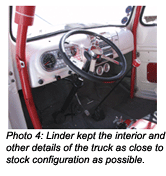 Wednesday, September 13
Wednesday, September 13
Linder’s record attempt preparations included bringing a spare engine, transmission, rear axle third member and tires along to cover any mechanical failure. The flat head engine installed for Linder’s first attempt (see Photo 5) is stroked with a Mercury 4” crankshaft and bored 0.125” oversize to 289 cubic inches displacement. The Edelbrock aluminum cylinder heads are bolted to a ported and relieved block that delivers an 8:1 compression ratio. The engine also features an Offenhauser 180-degree intake manifold, Mallory point ignition, Schneider camshaft and a 600 cfm Holley carburetor.
The second “back-up” engine is similar, but with a bigger bore, a more radical camshaft and a pair of Offenhauser Bonneville aluminum, high-flow, high-compression cylinder heads that are designed for use on an engine block that hasn’t had the valve pocket area relieved in the classical manner.
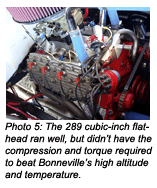 At this point, let me interject that flathead engines are inherently limited on compression ratio (c/r) because of the large valve pockets built into the cylinder head. The stock c/r of the late-model flatheads was about 7.2:1. Installing high-compression aluminum heads could push the c/r to 9:1, providing the valve pocket hadn’t been relieved to improve air flow at lower valve lifts. Compression ratios of 10:1 can be achieved, but only with a careful fitting of the block, pistons, heads and combustion chambers. In addition to the 3.50 axle ratio in the truck, Linder brought a 3.72:1 ratio to use with the higher compression engine.
At this point, let me interject that flathead engines are inherently limited on compression ratio (c/r) because of the large valve pockets built into the cylinder head. The stock c/r of the late-model flatheads was about 7.2:1. Installing high-compression aluminum heads could push the c/r to 9:1, providing the valve pocket hadn’t been relieved to improve air flow at lower valve lifts. Compression ratios of 10:1 can be achieved, but only with a careful fitting of the block, pistons, heads and combustion chambers. In addition to the 3.50 axle ratio in the truck, Linder brought a 3.72:1 ratio to use with the higher compression engine.
Linder decided to leave the milder engine installed since it had already hit 110 mph during initial testing at Indianapolis’ sea-level altitude. Linder’s plan was to install the high-compression engine if the original failed to break the speed record.
In addition, the truck had been wind-tunnel tested to mitigate the relatively poor aerodynamics of the truck body. Although the ’49 has less frontal area than the early ’50s truck bodies, it does have issues with air pressure collecting under the front fenders and in front of the nearly vertical windshield. Lowering the front of truck reduced airflow into the fender wells, but wind-tunnel testing indicated that tilting the windshield closer to vertical negated the gains from lowering. To split the difference, Linder’s team raised the front and moved the front wheels closer to the edge of the fender well by adding four inches width to the front axle.
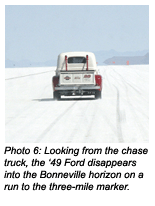 The morning began with cool, blue-sky weather and little humidity — ideal conditions for setting a speed record. Linder’s first trip down the three-mile-long course posted 97.127 mph, which turned out to be the ’49 Ford’s top speed for the event (Photo 6). As the temperature rose into the high 90s, the second run netted a disappointing 95.96 mph, which was 6 mph short of beating the existing speed record.
The morning began with cool, blue-sky weather and little humidity — ideal conditions for setting a speed record. Linder’s first trip down the three-mile-long course posted 97.127 mph, which turned out to be the ’49 Ford’s top speed for the event (Photo 6). As the temperature rose into the high 90s, the second run netted a disappointing 95.96 mph, which was 6 mph short of beating the existing speed record.
According to Starr’s air density ratio (ADR) calculations, Bonneville’s 4,200’ altitude combined with rapidly increasing air temperature was pushing the ADR toward the 6,000’ effective altitude mark. Starr estimated that the venerable flathead V8 had lost about 20% of its sea-level horsepower. Not to be disheartened by the news, Linder joked, “The engine’s running OK, but the speedometer just isn’t speedometering enough.”
To compensate for increases in altitude and temperature, Linder began reducing carburetor jetting and tire diameter. On the initial run, the flathead V8 turned about 4,100 rpm at 97 mph. According to the math, changing from an 89” circumference tire to an 84” tire on the 3.50:1 ratio 9” Ford rear axle would bring the engine speed up to about 4,300 rpm. Unfortunately, the ’49 Ford pickup responded negatively to the tuning and tire changes. The truck hovered around 95-96 mph mark throughout the remainder of the day.
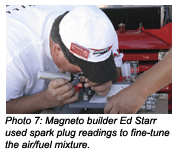 Thursday, September 14
Thursday, September 14
Truck co-owner Don Basala and owner of DD Sprinters, a company that specializes in hot rod fabrication and Indy roadster restoration, took over the driving chores while Linder and Starr attempted to unravel the reason why the engine was slowing down (see Photo 7). Oddly enough, the spark plugs appeared relatively clean, which indicated that the air/fuel ratios weren’t far from what Linder habitually refers to as “Lambda”.
Despite the various performance tweaks, the engine dropped incrementally from 95 mph to nearly 90 mph by the end of the day. Frustrated, Linder tried to save the day by changing the jetting and tires back to where they had been the previous morning. The changes resulted in the truck posting its slowest speed of the day. Even more ominously, rain began spattering the salt, which made the barometric pressure and relative humidity more unpredictable for tuning the engine.
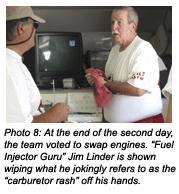 At day’s end, Linder called the team together to vote on whether the larger engine should be installed. The team voted an enthusiastic “yes” to swapping engines at the crack of dawn the following day (see Photo 8).
At day’s end, Linder called the team together to vote on whether the larger engine should be installed. The team voted an enthusiastic “yes” to swapping engines at the crack of dawn the following day (see Photo 8).
Friday, September 15
Our hearts sank as we returned to our hotel rooms in Wendover driving through an evening shower. The weather didn’t look good, but all that Linder and his team could hope for was that dawn would bring a brighter day. It was with utter dismay that I drove out to the track Friday morning and saw a wide expanse of inland sea stretching for miles. I reached Linder’s pit just as the team had loaded the ’49 Ford onto the back of their International car hauler bus. Starr had packed his equipment trailer and some team members were busy digging up some Bonneville salt to take to the folks back home. Linder was busy saying goodbye to all of the friends and business associates who had followed him to the salt. His plans for next year’s World of Speed may include installing mechanical fuel injection and spending a lot of dynamometer time working out the temperature and altitude-related tuning problems that handicapped this year’s attempt. All in all, 2007 promises to be a great year. Stay tuned.

